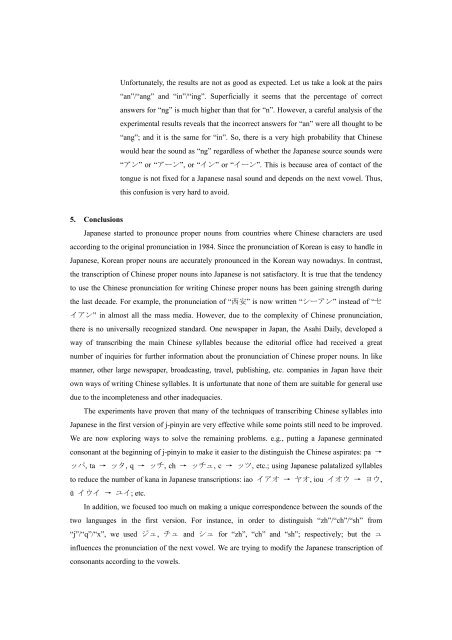j-pinyin: A New Systematic Approach to the Japanese Transcription ...
j-pinyin: A New Systematic Approach to the Japanese Transcription ...
j-pinyin: A New Systematic Approach to the Japanese Transcription ...
Create successful ePaper yourself
Turn your PDF publications into a flip-book with our unique Google optimized e-Paper software.
Unfortunately, <strong>the</strong> results are not as good as expected. Let us take a look at <strong>the</strong> pairs“an”/“ang” and “in”/“ing”. Superficially it seems that <strong>the</strong> percentage of correctanswers for “ng” is much higher than that for “n”. However, a careful analysis of <strong>the</strong>experimental results reveals that <strong>the</strong> incorrect answers for “an” were all thought <strong>to</strong> be“ang”; and it is <strong>the</strong> same for “in”. So, <strong>the</strong>re is a very high probability that Chinesewould hear <strong>the</strong> sound as “ng” regardless of whe<strong>the</strong>r <strong>the</strong> <strong>Japanese</strong> source sounds were“アン” or “アーン”, or “イン” or “イーン”. This is because area of contact of <strong>the</strong><strong>to</strong>ngue is not fixed for a <strong>Japanese</strong> nasal sound and depends on <strong>the</strong> next vowel. Thus,this confusion is very hard <strong>to</strong> avoid.5. Conclusions<strong>Japanese</strong> started <strong>to</strong> pronounce proper nouns from countries where Chinese characters are usedaccording <strong>to</strong> <strong>the</strong> original pronunciation in 1984. Since <strong>the</strong> pronunciation of Korean is easy <strong>to</strong> handle in<strong>Japanese</strong>, Korean proper nouns are accurately pronounced in <strong>the</strong> Korean way nowadays. In contrast,<strong>the</strong> transcription of Chinese proper nouns in<strong>to</strong> <strong>Japanese</strong> is not satisfac<strong>to</strong>ry. It is true that <strong>the</strong> tendency<strong>to</strong> use <strong>the</strong> Chinese pronunciation for writing Chinese proper nouns has been gaining strength during<strong>the</strong> last decade. For example, <strong>the</strong> pronunciation of “ 西 安 ” is now written “シーアン” instead of “セイアン” in almost all <strong>the</strong> mass media. However, due <strong>to</strong> <strong>the</strong> complexity of Chinese pronunciation,<strong>the</strong>re is no universally recognized standard. One newspaper in Japan, <strong>the</strong> Asahi Daily, developed away of transcribing <strong>the</strong> main Chinese syllables because <strong>the</strong> edi<strong>to</strong>rial office had received a greatnumber of inquiries for fur<strong>the</strong>r information about <strong>the</strong> pronunciation of Chinese proper nouns. In likemanner, o<strong>the</strong>r large newspaper, broadcasting, travel, publishing, etc. companies in Japan have <strong>the</strong>irown ways of writing Chinese syllables. It is unfortunate that none of <strong>the</strong>m are suitable for general usedue <strong>to</strong> <strong>the</strong> incompleteness and o<strong>the</strong>r inadequacies.The experiments have proven that many of <strong>the</strong> techniques of transcribing Chinese syllables in<strong>to</strong><strong>Japanese</strong> in <strong>the</strong> first version of j-<strong>pinyin</strong> are very effective while some points still need <strong>to</strong> be improved.We are now exploring ways <strong>to</strong> solve <strong>the</strong> remaining problems. e.g., putting a <strong>Japanese</strong> germinatedconsonant at <strong>the</strong> beginning of j-<strong>pinyin</strong> <strong>to</strong> make it easier <strong>to</strong> <strong>the</strong> distinguish <strong>the</strong> Chinese aspirates: pa →ッパ, ta → ッタ, q → ッチ, ch → ッチュ, c → ッツ, etc.; using <strong>Japanese</strong> palatalized syllables<strong>to</strong> reduce <strong>the</strong> number of kana in <strong>Japanese</strong> transcriptions: iao イアオ → ヤオ, iou イオウ → ヨウ,ü イウイ → ユイ; etc.In addition, we focused <strong>to</strong>o much on making a unique correspondence between <strong>the</strong> sounds of <strong>the</strong>two languages in <strong>the</strong> first version. For instance, in order <strong>to</strong> distinguish “zh”/“ch”/“sh” from“j”/“q”/“x”, we used ジュ, チュ and シュ for “zh”, “ch” and “sh”; respectively; but <strong>the</strong> ュinfluences <strong>the</strong> pronunciation of <strong>the</strong> next vowel. We are trying <strong>to</strong> modify <strong>the</strong> <strong>Japanese</strong> transcription ofconsonants according <strong>to</strong> <strong>the</strong> vowels.


